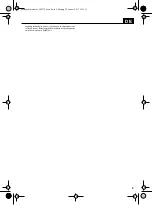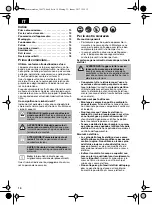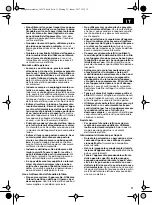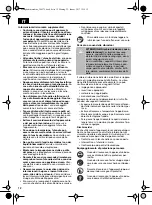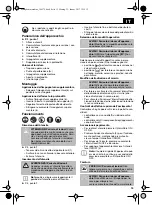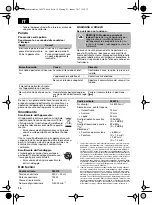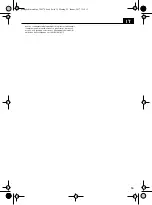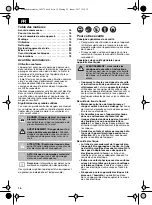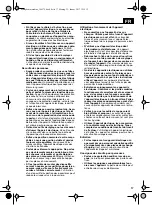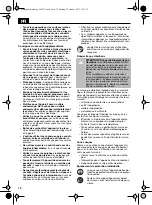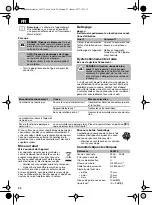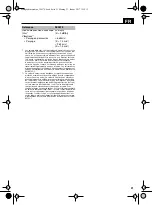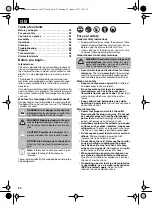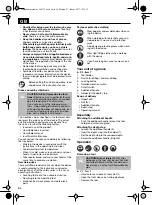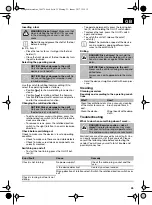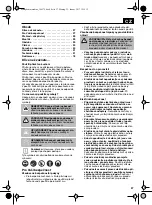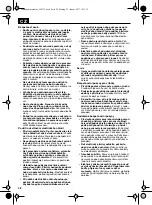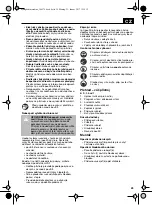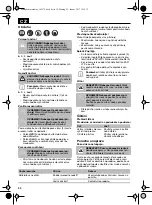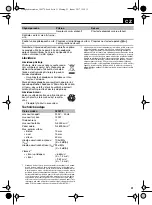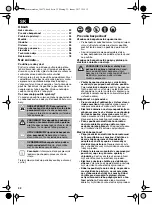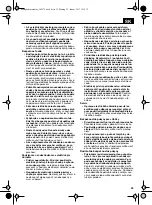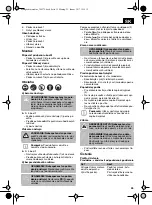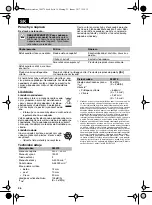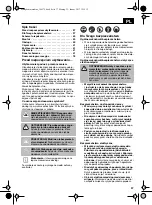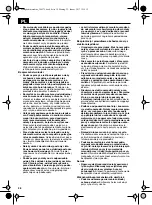
23
Personal safety
• Stay alert, watch what you are doing and use
common sense when operating a power tool.
Do not use a power tool while you are tired or
under the influence of drugs, alcohol or med-
ication.
A moment of inattention while operating
power tools may result in serious personal injury.
• Use personal protective equipment. Always
wear eye protection.
Protective equipment
such as dust mask, non-skid safety shoes, hard
hat, or hearing protection used for appropriate
conditions will reduce personal injuries.
• Prevent unintentional starting. Ensure the
switch is in the off-position before connect-
ing to power source and/or battery pack,
picking up or carrying the tool.
Carrying
power tools with your finger on the switch or
energizing power tools that have the switch on
invites accidents.
• Remove any adjusting key or wrench before
turning the power tool on.
A wrench or a key
left attached to a rotating part of the power tool
may result in personal injury.
• Do not overreach. Keep proper footing and
balance at all times.
This enables better con-
trol of the power tool in unexpected situations.
• Dress properly. Do not wear loose clothing or
jewellery. Keep your hair, clothing and gloves
away from moving parts.
Loose clothes, jewel-
lery or long hair can be caught in moving parts.
• If devices are provided for the connection of
dust extraction and collection facilities,
ensure these are connected and properly
used.
Use of these devices can reduce dust-
related hazards.
Power tool use and care
• Do not force the power tool. Use the correct
power tool for your application.
The correct
power tool will do the job better and safer at the
rate for which it was designed.
• Do not use the power tool if the switch does
not turn it on and off.
Any power tool that can-
not be controlled with the switch is dangerous
and must be repaired.
• Disconnect the plug from the power source
and/or the battery pack from the power tool
before making any adjustments, changing
accessories, or storing power tools.
Such
preventive safety measures reduce the risk of
starting the power tool accidentally.
• Store idle power tools out of the reach of chil-
dren and do not allow persons unfamiliar with
the power tool or these instructions to oper-
ate the power tool.
Power tools are dangerous
in the hands of untrained users.
• Maintain power tools. Check for misalign-
ment or binding of moving parts, breakage of
parts and any other condition that may affect
the power tool’s operation. If damaged, have
the power tool repaired before use.
Many
accidents are caused by poorly maintained
power tools.
• Keep cutting tools sharp and clean.
Properly
maintained cutting tools with sharp cutting
edges are less likely to bind and are easier to
control.
• Use the power tool, accessories and tool bits
etc. in accordance with these instructions,
taking into account the working conditions
and the work to be performed.
Use of the
power tool for operations different from those
intended could result in a hazardous situation.
Service
• Have your power tool serviced by a qualified
repair person using only identical replace-
ment parts.
This will ensure that the safety of
the power tool is maintained.
Safety notes for drills
• Wear ear defenders when hammer drilling.
The effects of noise can result in a loss of hear-
ing.
• Use the additional handles supplied with the
device.
Losing control may cause injuries.
• Hold the device by the insulated surfaces
when carrying out work during which it is
possible that the tool or screw may come
across hidden power cables or its own cable.
Contact with a cable that carries power will sub-
ject the metal parts of the device to current and
will lead to electrical shock.
Additional safety notes
• Prior to starting work, use appropriate tool to
determine whether there are any hidden sup-
ply lines are located on the area you are work-
ing in. If in doubt, ask the relevant supply ser-
vices.
Contact with power lines may cause fire
and electrical shock. Damaging a gas pipe may
cause an explosion. Damaging a water pipe
leads to considerable property damage and may
cause electrical shock.
• Wait until the power tool has come to a stand-
still before you put it down.
The inserted tool
may otherwise jam and cause a loss of control
over the power tool.
• Secure the work piece.
Use tensioning equip-
ment or a vice to secure the work piece to help
prevent kickback or uncontrolled flying of the
work piece (e.g. when getting jammed in the
work piece).
• Immediately switch off the power tool when
the inserted tool becomes blocked. Be pre-
pared for high responses instances in the
event of kickback.
The inserted tool will jam
when the power tool is overloaded or tilted
within the work piece.
• Never use the power tool with a damaged
cable. Do not touch a damaged cable and pull
out the power plug.
Damaged cables increase
the risk of electric shock.
• Keep cutting tools sharp and clean.
Properly
maintained cutting tools with sharp cutting
edges are less likely to jam and are easier to con-
trol.
• Prevent overheating of the device and the
work piece.
Excess heat may damage the tool
and the device.
GB
Schlagbohrmaschine_380379.book Seite 23 Montag, 23. Januar 2017 12:19 12
Содержание 380379
Страница 3: ...3 1 2 6 7 3 5 4 1 1 2 Schlagbohrmaschine_380379 book Seite 3 Montag 23 Januar 2017 12 19 12 ...
Страница 81: ...81 Schlagbohrmaschine_380379 book Seite 81 Montag 23 Januar 2017 12 19 12 ...
Страница 82: ...82 Schlagbohrmaschine_380379 book Seite 82 Montag 23 Januar 2017 12 19 12 ...
Страница 83: ...83 Schlagbohrmaschine_380379 book Seite 83 Montag 23 Januar 2017 12 19 12 ...

